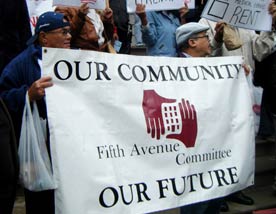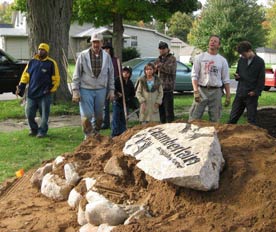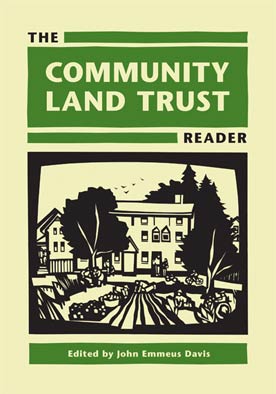
The Fifth Avenue Committee, a neighborhood-based organization from Brooklyn, New York, participates in a citywide rally against rent increases for rent-stabilized apartments in October 2009. Photo courtesy of the West Side Neighborhood Alliance
In May 2009, a coalition of more than 60 New York City organizations held a one-day forum called “One City, One Future” to present a citywide economic development vision that was equitable and beneficial to all New Yorkers. The forum, accompanied by a report of the same name, was the result of more than three years of meetings, discussions, and workshops around the city as the coalition was building a broad base of support and collaboration from unions, CDCs, and other organizations. Central to this effort was the work of one CDC in Brooklyn called Fifth Avenue Committee, which devoted a great deal of time and energy to build this citywide collaborative effort.
Fifth Avenue Committee (FAC) is a CDC that in many ways is like others around the country. But unlike too many of its sibling organizations whose work has been truncated and narrowed, FAC consistently works beyond the realm of its community, as do two other imperfect organizations — ACORN and Montreal’s Immigrant Workers Centre. Groups like these look at the bigger picture because they realize that if social and economic justice is to become a reality in a community, then changes larger than the community must take place.
The Incredible Growing/Shrinking Community
Community and community groups are hot — and they’ve been hot for a long time. Community is where public policy increasingly expects the “solutions” to social problems to be found. This turn to the community has, for many community-based nonprofit organizations, generated a mini-boom (at least until a year or so ago) in terms of funding, recognition, and stature. But it has also too often come at the expense of a proper understanding of what communities are and realistic expectations of what community organizations can and should do.
The growth in a community’s importance, which was heavily supported by government and private foundation funding worldwide, has been mirrored by a diminished set of critical political perspectives, which has, in turn been accompanied (and accomplished) by a focus on the community in and of itself. As a result, community has been embraced in ways that are simultaneously too ambitious and too modest.
The “Nonprofitization” of Social Welfare
There has been a significant shift in the way the delivery systems of housing and social services are funded and organized. The movement of social services and housing to the community has also been accompanied by a whole range of theories and practices of community that actively embrace the central role that community is now playing. There has long been a strand in Western thought that could be called “communitarian” and policymakers, foundations, and nonprofits have given that strand of thought a lot of attention over the last 25 years.
Thinkers such as Robert Putnam and Amitai Etzioni have brought the concept of communitarianism to regular meetings at the White House, 10 Downing Street, and other corridors of power. While Putnam’s work on social capital and “bowling alone” might seem a bit removed from community organizations’ practices, when you examine the buzzes and fads that have surrounded the field of community development in the last 20 years — tactics such as asset-based development, consensus organizing, and community building — they all have clear echoes of the communitarian approaches of Putnam, Etzioni, and the like.
Because of these often unexamined intellectual roots, there are two basic assumptions that are common in the community development field. First is the assumption that the community is the source of its own problems and therefore has the capacity to solve them. This is just as true for the asset-based development perspective.
The problem, of course, with this whole premise is that communities are produced through a web of internal and external forces and relationships. Anyone who has looked at the landscapes of foreclosed properties that litter American cities knows what happens in a community is often in large part a result of external forces and processes (in this case, the connection of residential property to global capital markets and a state that is unwilling to regulate such markets).
While foreclosures are just one indication of external forces at play in communities, the point is that communities are too connected to larger-scale forces to be able to control their own development.
The second basic assumption about community development work is that all relationships are good for the long term, and that conflict can be ignored or assumed away. This assumption is present in ways of understanding communities that are deliberately inward looking (such as community-building or assets-based work), as well as in the consensus organizing model and its intellectual sibling, the new regionalism being promoted by the Brookings Institution and others. But conflict and power relations shouldn’t be ignored or assumed away.





Comments